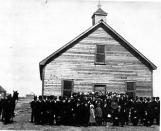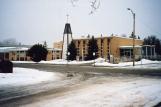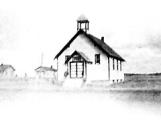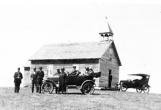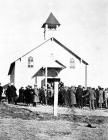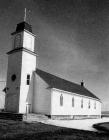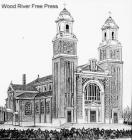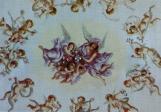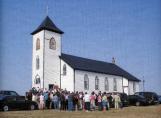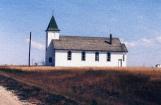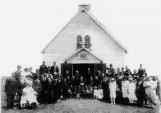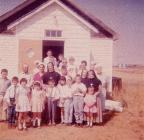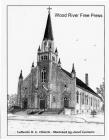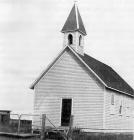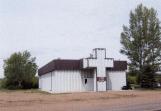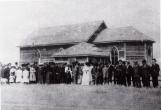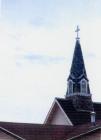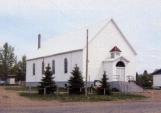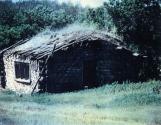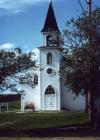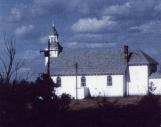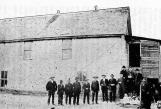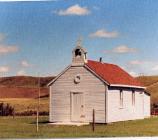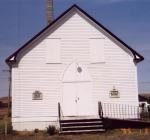

Assiniboia and District Historical Museum
Assiniboia, Saskatchewan
2
Catholic Churches in South Central SaskatchewanIn 1906, His Grace Most Reverend A. Langevin OMI, Archbishop of Saint Boniface, whose diocese extended west to the Alberta border, sent out missionaries to serve the faithful.
Early key pastors that evangelized in the northwest corner of South Central Saskatchewan of this 80k (50 mile) radius of Assiniboia :
Fr. Pierre Gravel, easterner, formerly stationed in New York USA worked from Regina to Gravelbourg circa 1906.
In the east of this area was Father Lestanc of Quimper, Brittany, who worked in the Willow Bunch area circa 1870.
In the west was Father Bois of Poitiers, France. He was a priest/homesteader who worked from Meyronne circa 1909.
4
Assiniboia St. George Roman Catholic Church First BuildingWillow Bunch Roman Catholics had been well established before many of the area settlements and priests traveled from this centre. Assiniboia was the first parish to be detached from Willow Bunch.
Fr. Lemieux traveled to visit the faithful in the mission of Leeville (forerunner of Assiniboia) in 1909. The services were held in local homes.
In 1912, due to the CPR rail line running south of Leeville and the establishment of the roundhouse at Assiniboia, the Town of Leeville moved to become part of Assiniboia. The first wedding took place on the groom's farm in a granary.
The first church and rectory were built in April of 1913. Fr. Sammut, a native of Malta, helped with the construction. Maxstone and Limerick became mission points. Later there were renovations, which included the addition of the bell tower.
6
Assiniboia St. George Roman Catholic Church Present DayA new church was built in 1963; a beautiful and modern parish centre was added in 1996. A fresh renovation was done in 2000.
They currently have a resident priest.
8
Bengough St. Michael's Roman CatholicThe parish records show the first baptism to be Thomas John Adams, son of Joe and Eva Adams, by Rev. G. Mulligan on August 5th, 1917.
Bengough had been a mission until Rev. L. Sullivan established a residence in Bengough, thus a parish was established. He then purchased a large unused church in Verwood in 1956 and despite great difficulties had it moved to the present site. The debt was soon liquidated largely through a generous bequest by the late Mr. Hugo Allgayer. A new rectory was subsequently built.
Services continue at the present.
10
Coderre St. Charles Roman CatholicIn 1910, the settlers from North Dakota were organized in the area. Church services were held in Messers. L de Courval and Philias Desnoyer's home, which served as a chapel. In August 1913 a rectory was built and served as a chapel until the church was completed that December. And as with many of the settled sites, CPR dictates a move of buildings with the hauling of the church and rectory in 1925. The lots for building were donated by the CPR and a gift offering in the amount of $500.00. Since 1950 the Coderre parish priest has Courval as a mission.
Up until 1925 Coderre was one parish with Courval. It is presently a mission point from Hodgeville.
12
Courval St. Joseph's Roman Catholic ChurchThis area was settled in 1908. Church services were held in Mr. L. de Courval's home. The first traveling priest was Fr. Pierre Gravel.
Courval was one parish with Coderre until 1925. With the moving of the St. Charles Church closer to Coderre due to the rail line, Courval wanted to have their own parish. On August 27, they had their own first service held in the Separate School. On September 11 of the same year a new cemetery site was chosen.
The planning of the church building concluded with the hauling of lumber from Mortlach, free of charge by parishioners. Much the same story for most of the church building. The first service in the new church was held August 12, 1928 by Fr. Giguere. Last resident priest left in 1950, and the church became a mission point of Coderre until 1981.
The building became a teacherage in 1956 to 1967, and then was dismantled for lumber.
COURVAL OLD WIVES ROMAN CATHOLIC MISSION
Italian families settled in this area.
Before 1930 it was part of the Regina Diocese until the founding of the Gravelbourg Diocese. It then became a mission point out of St. Joseph's in Moose Jaw.
Later the resident clergy from Courval held the services, which had been held at Old Wives School, then at Bay Island School.
With the departure of the Courval resident priest in 1950 this parish dissolved and parishioners attended services at other points.
14
Coronach Roman Catholic Our Lady of Perpetual HelpThe few Catholics in that area usually waited for the missionary priest to visit them, but those of deeper faith traveled to Willow Bunch at least for their Easter Duties and to have their children baptized.
The second pastor at Fife Lake, Fr. A.L. Roy, began to visit the town once or twice a month and held services in the school or above the pool hall.
Rev. Villeneuve, first Bishop of Gravelbourg, who became Archbishop of Quebec, asked the CWL of his city to make a collection for the building of a chapel in Coronach. The construction of the first church was finished by July 1936.
The money collected by the Quebec CWL gave this congregation money on the condition that the church be named after their patron saint and that a CWL be organized. The Coronach ladies received their charter in 1938 making them the oldest sub-division of the CWL in the diocese.
16
Coronach Roman Catholic Our Lady of Perpetual Help 2005Since 1954 the church has had a finished basement and a new porch.
The congregation is currently served by the Resident Priest from Rockglen
18
Fife Lake Christ the King Roman Catholic Church First BuildingFrench, German, Belgian, Scottish and English settlers came between 1908 and 1910 and depended on spiritual solace from Willow Bunch.
The first missionary was Fr. Jacob Wilhelm, from Germany, who traveled about the vast area from Radville to Wood Mountain.
The first chapel was built in 1924, ¾ K (one half mile) north of the present town, where the Catholic cemetery now stands.
In 1926 the CPR arrived and the church was moved closer to this site.
20
Fife Lake Christ the King Roman Catholic Church Second Building1928 saw the building of a much needed larger building to hold the 100 families of the congregation. The chapel was sold to the Anglican Bishop and closed sometime later. In 1953 this building was moved to Rockglen to serve as the Anglican Hall.
From 1928 there was always a resident priest who served two mission points, Coronach and East Poplar.
After 52 years of service to the community, in July of 1980, Christ the King Church was sold and moved to a farm near Coronach, to be used as a shop.
21
Fir Mountain Area Sister Butte St Marcel Roman Catholic Church1917
Fir Mountain (area), Saskatchewan
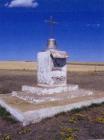
22
Fir Mountain Area Sister Butte St Marcel Roman Catholic ChurchServices were held in private homes in the early years.
Saint Marcel Roman Catholic Church was built in 1917.
Five acres of land on SW 26-6-6 was donated by Dezso Sandor for a church and a cemetery. The large bell, church organ and vestments were ordered from Austria. Fr. Julius Bois was the first priest to hold mass in this church. He came from Meyronne on horse back. The last priest to hold mass was Fr. P Jerome. On July 9, 1954, it was struck by lightning and burnt to the ground with all contents. There still intermittent burial in this cemetery.
Today the large bell sits on the cement steps and rings only when hail hits it.
24
Glentworth St. Joseph Roman Catholic ChurchIt was in 1929 when the parish of St. Joseph was founded by Fr. J.A. Vachon. In 1931 the Chapel of Milly was moved and became the Church for Glentworth. Fr. Jerome became a long time resident priest in 1938. One year later Fir Mountain became a mission point. (The mission point of St. Marcel, south of the village, was destroyed by a fire.)
In 1955-1956 St. Joseph had a complete renovation. Fir Mountain and Wood Mountain missions had full service from here. Wood Mountain Reserve Church mission point is served once a month.
In 2005 there are two lay services and two regular services by priests from Rockglen and Assiniboia, each month.
26
Gravelbourg Notre-Dame-de-l'Assomption Roman Catholic CathedralOur Lady of Assumption Roman Catholic Co-Cathedral
Formerly known as Ste.-Philomene Roman Catholic Cathedral
Rev. L.P. Gravel of New York was commissioned to lay a foundation of a parish out west.
In 1907 Fr. Magnan arrived. The services were held in a tent.
In 1908 a chapel-resident was built with lumber hauled from Mortlach. The site was near the present day College Mathieu. The church was named Ste. Philomene.
28
Gravelbourg Notre-Dame-de-l'Assomption Roman Catholic CathedralOur Lady of Assumption Roman Catholic Co-Cathedral
Formerly known as Ste.-Philomene Roman Catholic Cathedral
First Building
In 1912 authorization to build a church was given. That fall the foundation of the first church was begun with Rev. Fr. Magnan. The basement for the second church was constructed with a roof and a single steeple and later became the foundation of the first part of College Mathieu. It was used for services until 1918.
30
Gravelbourg Notre-Dame-de-l'Assomption Roman Catholic CathedralOur Lady of Assumption Roman Catholic Co-Cathedral
Formerly known as Ste.-Philomene Roman Catholic Cathedral
Interior
Between the years 1918-1919 the building of the church began. It was built on the style of the Romanesque and Italian Renaissance - it has a steel structure, steel roof trusses and a concrete basement. The outside walls are made of fire-proof brick - light tan in color trimmed with Indiana limestone. This edifice was noted to be the most beautiful in the west and some say most remarkable in all of Canada due to the paintings of a master artist Father Maillard. He devoted ten years of his life (1921-1931) to the decoration of this church.
32
Gravelbourg Notre-Dame-de-l'Assomption Roman Catholic CathedralOur Lady of Assumption Roman Catholic Co-Cathedral
Formerly known as Ste.-Philomene Roman Catholic Cathedral
Interior Dome
In 1930 a new diocese was formed and the first bishop was Monsignor R. Villeneuve O.M.I. This edifice became a cathedral.
34
Gravelbourg Notre-Dame-de-l'Assomption Roman Catholic CathedralOur Lady of Assumption Roman Catholic Co-Cathedral
Formerly known as Ste.-Philomene Roman Catholic Cathedral
Interior Artwork
The cathedral was declared a National Heritage Property on March 26, 1987 along with the Bishop's Residence and the Jesus-Mary Convent.
Since 1998 the diocese of Gravelbourg no longer exists; affected parishes are now under the Regina Diocese once again. Rather than reverting to the simple status of a church, the cathedral was designated "co-cathedral". The last bishop was Monsignor Raymond Roussin, S.M.
36
Gravelbourg Area St. Elizabeth Roman Catholic ChurchIn 1909 settlers of German descent began to homestead in this area. Services were held in homes by Father Bois. Later Fr. Jacob Wilhelm, who had recently come to Canada, built three chapels - Grismerville, St. Mathias at Gooding and St. Elizabeth. This was accomplished between his stay from 1911 to 1915. He then purchased a homestead near the latter mission.
In 1912 Mr. Christof Schwartz built the first country chapel, St. Elizabeth. The chapel became unsuitable for the growing members, therefore it was torn down and another was built in 1927. This was during Fr. Milner of the USA and dedicated by Rev. Neilburg, OMI then the Provincial Superior of the New German Oblate Province. To build this church each parishioner was asked to donate $100.00.
This mission had been served for many years from Meyronne, then Hodgeville, Gravelbourg and Vanguard. It has now closed.
Rev. Don Bolan, presently residing in Rome, holds service once a year on his visits at St. Elizabeth.
38
Horizon St. Cunegunda Roman Catholic ChurchThe first church board was organized in 1906, but the congregation began earlier and services were held in the home of Mr. & Mrs. Wagner.
A church hall was built in 1915 and was then used for services.
By 1927 it had become a mission of Pangman.
St. Cunegunda Church was built in 1928. Later, a rectory was built, but is now gone and the church reverted to a hall in 1994. The congregation had been a mission of Bengough. Father Moullard traveled by horse and buggy from Weyburn until the railway came. He then came by train.
40
Joeville Catholic ChapelMay 29th, 1916 a mission was established under the name of St-Joseph des Poissons. A Roman Catholic Chapel was built a Joeville in 1916 or 1917 by Ernest Lamontagne. The first priest was Fr. Rahard. Between 1919-21, a farmer priest, Fr. F.M. Gendron came from his ranch in the region to dispense religious services.
The chapel was moved in 1926 to a new location due to the railway construction. The new site was named Lisieux. In 1927 this chapel became the rectory at the new site.
This photo was taken at the Grand Opening in 1922 with parishioners in attendance
42
Kantenville Roman CatholicBetween 1907 and 1922, Little Woody and Kantenville were mission points usually served from Willow Bunch.
Kantenville, composed mainly of French Canadians, "posses a beautiful chapel" which was largely built in 1917 by Father Victor Rahard. Its first missionary and the structure was finished in 1919 by Father Menard.
In Little-Woody most of the families were French, German and Irish, as were other mission points from here, Quantock and Hart.
These diverse missions were paralyzed in their development due to lack of communications and great distances - 40, 48, and 64 kms (25, 30 and 40 m.) from the railroad.
44
Killdeer St. James the Major Roman Catholic ChurchMasses were first held in homes. Some of the congregation traveled across the USA border by horse and buggy to attend Mass there.
In 1952 a school was purchased. Art Labays donated a lot from his land next to Killdeer for the building.
In 1955 the church was dedicated by Aime Decosse (Bishop)
Mrs. Jessie Noonan donated $100.00 for a chalice.
Proceeds from the 1956 fowl supper bought a floor furnace and a church organ.
In 1979 as a result of fire damage the United Church Chapel was used for the services.
Due to a dwindling congregation the church was closed in the early 1980s. The church was sold to a sheep rancher.
46
Lafleche Area Plessis Roman Catholic Mission ChurchSte. Therese Roman Catholic Church of the Plessis School District south of Lafleche, was built in 1914 under the instruction of Fr. Dubois. August Cantin donated the four acres of land for the mission church site. The priest from Lafleche held the services there until Fr. Vachon came to Glentworth as a parish priest in 1929. The church was renovated during F. Jerome's charge then it was moved to Wood Mountain in 1954.
The services were attended by parishioners from Fir Mountain, Flintoft and Glentworth.
Unfortunately it burnt down in 1978 at its new site in Wood Mountain.
48
Lafleche Ste. Radegonde Roman Catholic Church 1st BuildingReligious services were offered in homes from 1908 to 1912, and later in a public school. In the fall of 1912 plans were laid to build a church and rectory. The basement was dug and that served as a church until funds were available for the top storey. With a growing community they realized that this building would be inadequate.
50
Lafleche Ste. Radegonde Roman Catholic Church 2nd BuildingThe new church building began May 1922, a 56' x 102' brick structure with seating capacity of 650. "There was not then five other churches as beautiful in the archdiocese of Regina and its Gothic steeple the nicest in the west" (Historical Sketches 1930-1955, page 60). The first permanent priest was Fr. Dubois who arrived from France in May 1914.
The first church became the Legion Hall. The last resident priest was in 1995. It is now served from Gravelbourg. The rectory was sold in 1996. The church became a Heritage Site.
52
Limerick St. Mary's Roman Catholic ChurchSt. Mary's was a mission served by the priests from Lafleche, Meyronne, Hodgeville, Mazenod, Assiniboia and Gravelbourg.
Before the church was built, services were held in the dance hall above a store, at the Limerick School, in the building of the printing press, and most often in private homes.
Construction of the church began in the summer of 1922. The first service was the Christmas Mass that year. The congregation sat on horse-blanketed planks.
Successful Fowl Suppers were held annually in the Limerick Hotel. The building was sold in 1976. The contents were moved to other needy parishes. The church was dismantled for lumber. Parishioners now attend St. George's Church in Assiniboia.
54
Lisieux Ste. Therese Roman Catholic Church Earlier YearsOn May 29, 1916 a mission was established under the name of St. Joseph des Poissons.
The small original chapel was built at Joeville. Fr. Rahard was the first priest.
Between 1919 and 1921 a farmer priest, Fr. F.M. Gendron came from his ranch in the region to dispense religious services. In 1926 the parish was renamed, Ste. Therese de l'Enfant Jesus. In the same year the CPR named the station Lisieux and the Postal Department agreed to give the same name to the former Joeville Post Office. In the fall the village moved closer to the railway station and so too was the chapel moved. A proper church was built in late 1926. A fire struck in 1939. Rebuilding was started (due to the generous donation of 4000 bushels of wheat by local farmers) and the church was consecrated July 1, 1941.
It was destroyed by a fire once again in 1990.
56
Lisieux Ste. Therese Roman Catholic Church Present DayThe church was rebuilt and included a community hall.
The celebration of the 75th Anniversary of annual pilgrimage was celebrated in 2005. It is presently serviced from Rockglen.
58
Mazenod Sacred Heart Roman Catholic ChurchFrom July 1912, Father L.P. Gravel of Gravelbourg, ever prominent in this vast area, came every first and third Sunday of the month to celebrate mass. These were held in the Budweis School. Eventually the need of a church was evident with the ever growing parochial unit.
The parish of Mazenod was taken from the eastern portion of the Gravelbourg Parish and in 1915 construction of the Sacred Heart Church began. The farmers dug and made the basement.
Fr. A. Gravel of Montreal, cousin of the above priest, was the first resident priest. Palmer and Mossbank were mission points until 1940.
The parishioners were diligent to meet the obligation springing from church and priest support. In 1919 still in the horse and buggy days, a bazaar brought in $1,745.30.
Renovations took place in the 1950s and a steeple with chimes was installed.
The church closed in 1981, was next used for storage, and later sold.
60
Maxstone St. Mary's Roman Catholic ChurchMost parishioners were of Austrian decent, attending irregular services at the home of Ed Lolacher Sr., with priests from Willow Bunch, Assiniboia, St. Victor, and traveling missionary Fr. Wilhem.
Construction of the church began in the spring of 1917, by Ed Lolacher (a stone mason and church builder), Anton Kwasnicki and John Pilsner (both carpenters trained in the old country). With a foundation made of field stone and lumber from Assiniboia, the church was built on land donated by Ed Lolacher.
Due to a shortage of priests the mission was closed in 1969. Services and fellowship are held at least once a year, on Father's Day with many former members and friends.
Parishioners now participate at Assiniboia and Lisieux. The building has now become a church museum.
62
Meyronne Our Lady of Lourdes ParishThe parish was born on July 12, 1909 with the arrival of Fr. Jules Bois from Poitiers, France. Fr. Bois settled on NW 32-8-7 W3rd. The first services were in the Le Gentil's Inn. The church was built in 1910.
Meyronne moved closer to the new CPR rail line approximately 3km (two miles) north and eventually plans were made to have the church moved also. It took three tractors to haul the building over a mud flat. That Sunday the service was held while the building was on blocks.
August 27th, 1913 it was ready for the consecration at the new site. The church was enlarged but was consumed by fire in 1917.
August 16th, 1920 the first service was held in the basement for the incomplete second building which is still in use today. It is now a mission point from Gravelbourg.
64
Mossbank St. Louis Roman Catholic ChurchThe St. Louis Parish, always a mission, was organized by Fr. Gravel in 1917. The church was built in Mossbank, halfway between Mazenod and Expanse at the cost of $2,000.00. Until then the church point had been at Expanse served by Moose Jaw. This cut into the Expanse parish numbers and St. Louis's few members had a large debt. Fr. Paquette of Moose Jaw had charge of the Mossbank Mission until 1920. Services were held only once a month, then in 1922 twice a month. In the 1930's, when an assistant priest came to Mazenod, a weekly service was established.
The St. Louis Mission has the distinction of being the only mission served by its bishop, Mgr. Lemieux from 1942 to 1945.
In the 1940's stained glass windows were installed through the generous donation of Herman Lambertus, Hal Brodin and Alfred Voisin.
Fr. Branch, a chaplain at the Mossbank airbase, also served here in the 1940's.
The mortgage burning took place in 1966. The renovations took place in 1977-78 by volunteers. It is presently serviced by the resident priest from Assiniboia, three Sundays a month and the fourth Sunday is a lay service.
66
Palmer St. Oliver's Roman Catholic ChurchThe first mass was celebrated in the territory then covered by St. Oliver's Church of Palmer, was held by Father Gravel on May 17, 1914, at the home of Mr. Bonneau. One of the extraordinary facts worth mentioning is that one family came to Mass using a two-horse road fresno (scraper) as a vehicle.
St. Oliver's Church was built in the fall of 1916. The cost of the building was $4,200.00 of which the sum of $2,400.00 had been raised at the time of the construction.
From 1917 until 1920 efforts to have a resident priest were difficult, and it remained a mission out from Mazenod, served by Fr. Albert Gravel and Fr. Knauff until 1950. At this time the parish was now separated from Mazenod.
Fr. Laprise was the last parish priest until the closing of the church in 1970 when the mission was attached to Gravelbourg and the building sold.
68
Rockglen St. John Evangelist Roman Catholic ChurchMany German and Hungarian immigrants came from Winnipeg to settle in the well sheltered valley of Rockglen.
In 1914 Fr. Wilhelm traveled by buggy to provide for the spiritual needs of the people. The services were held in private homes and later in the Wheatbench School after it was built. In between infrequent visits of priests, the faithful traveled to Willow Bunch to attend Mass.
In 1917 Fr. John Hard, of Swiss origin, had a rectory cum chapel built on 5 acres bought from Mr. A. Lafort. The site was 8K (five miles) south of the present day Rockglen. Plans were made in 1918 but the construction only began in 1926-27. There were innumerable structural problems. In 1928 the church and rectory was moved to the present site.
70
Rockglen St. John Evangelist Roman Catholic Church Present DayThere was a small fire in 1948.
In 1956 a bell was bought for the steeple. The year 1962 saw the renovation of the basement to be used as a gathering place.
Currently they have a resident priest.
72
St. Victor Area Coulee ChapelleOn arrival from the Red River area of Manitoba around 1870, Fr. Lestanc and his Métis families had set up their tents around a modest chapel built about 5km (3 miles) east of the present church on the side of a coulee (a depression made by water erosion) near Montague Lake. This chapel was built of poles and clay.
During the winter the settlers abandoned their camp and went to Wood Mountain where they built a chapel and huts circa 1871. With the depletion of buffalos, the Métis returned to the Coulee Chapelle settlement. It was replaced in 1878, made the same way as the former chapel.
The Coulee Chapelle was a mission point from Willow Bunch.
The picture- the Coule Chapelle would have been built somewhat like this.
74
St. Victor Roman Catholic ChurchConstruction of the church and rectory began in 1914 on land donated by M. Alexandre McGillis. Consecration took place September 6, 1914 by Fr. Ignace Lemieux of Willow Bunch. The building of the parish hall began in 1916 and was completed in 1920. A front entrance was built and a bell tower was added in 1919. Completion of the interior and installation of pews took place in the late 1920's. The pews were brought from Gravelbourg two at a time.
The years 1944 and 1958 saw the ordinations of Fr. R. Ducharme and Fr. Jean-Paul Isabelle OMI.
The church closed in 1980 and became a church museum with the items still in their proper places. At present a few services are held for special occasions.
Note the facsimile of a Red River Cart in the photo of the church.
76
Spring Valley Mater Dolorosa Roman Catholic ChurchIt appears that the church was built in 1917. The former records have been lost. The rectory was built in 1928.
At the beginning, this was a mission field until Claybank received a resident priest who then served here also. Fr. J. Wilhelm was the first resident priest for a short term. Later Fr. Godin, the resident pastor of the Providence Hospital in Moose Jaw traveled here to serve the congregation.
A former high school building was purchased for a parish hall.
In 1968 much renovation took place in the church.
In the late 1960's the parish reverted to a mission parish once again. The rectory was sold in 1971.
Presently the resident pastor of Claybank serves here to an active congregation.
78
Verwood Our Lady of Lourdes Roman Catholic ChurchOur Lady of Lourdes was built in 1919 with the rectory built the following year. Later, an addition was built to the rear of the church.
First resident priest was Father Menard from 1918 until 1927.
During the early 1930's and 1940's the congregation was served with priests from St. Victor and Willow Bunch. From 1954 to 1956 Father Blanchard, who was employed by the Department of Indian Affairs, held services here occasionally.
The manse was sold in 1955. The church building was sold in 1956 and moved to Bengough.
80
Willow Bunch Area Bonneauville Roman Catholic ChurchAbout 1882, under Father Pierre St. Germain's directions, the Métis built a chapel-residence. A two-storey structure made of logs was milled on site. The upper level was the chapel and the lower level was the missionary's residence. It was opened for service in 1884. By 1889 a controversy arose over a new village site, this was settled in 1905. The chapel-residence was demolished and the lumber was used to build on the new site - 2.5 K (1 ½ miles) east of the present Willow Bunch
81
Willow Bunch St. Ignace de Saules Roman Catholic Church 1st Church1907
Willow Bunch, Saskatchewan

82
Willow Bunch St. Ignace de Saules Roman Catholic Church 1st ChurchThis is the oldest parish in the former Gravelbourg Diocese, and for the record, the second oldest parish in the province. This French Canadian centre was, for years, the hub from which radiated all expeditions that would create the neighbouring villages.
In 1905 the demolition of the Bonneauville chapel/resident by Rev. J. Lemieux saw a rectory built at the new town site - Willow Bunch, with this lumber. The next year a stone foundation was in place for the new church on land donated by J.L. Legare. About 1907 the church was completed and remained in operation until 1959. Rev. Charles Maillard of Gravelbourg painted three murals.
83
Willow Bunch St. Ignace de Saules Roman Catholic Church Present Day1959
Willow Bunch, Saskatchewan
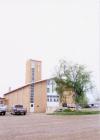
84
Willow Bunch St. Ignace de Saules Roman Catholic Church 2nd churchThe construction of the new church was finished with a dedication on March 5, 1959. Since then renovations have made a lot of improvements. The pastors are from Rockglen and Assiniboia at present.
86
Wood Mountain Area Roman Catholic ChurchA little Mission Chapel was built in 1871 by Fr. P. Lestanc, Oblate Missionary, 6.5km (four miles) from where Wood Mountain now stands.
The congregation was made up of 100 Metis families who were encamped in this area while they hunted and trapped for furs. The chapel was constructed of cut poles and clay. An addition was constructed to accommodate 175 Métis families. In the late 1870's another chapel was built 5 K (three miles) from the NWMP barracks. Building could have looked like this.
88
Wood Mountain Area Roman Catholic Church -present dayIn 1946 a chapel was constructed on the reserve where monthly services were held by the pastors from Rockglen and Glentworth.
90
Wood Mountain Roman Catholic ChurchCatholic services were held in the Village of Wood Mountain either in the hall or in private homes.
Some earlier pastors were Fr. Vachon who was then resident priest at Glentworth, then Fr. Jerome through whose instigation had the chapel - St. Therese - moved in from the Plessis District in 1954. The chapel was destroyed by fire in 1978.
Presently the congregation shares a church with the Wood Mountain United Church since the summer of 1979. The building was the former Mennonite Brethren's Church of Woodrow that was moved to this site in 1958. Currently they have lay services and visiting pastors.
91
Glentworth Assumption of the Blessed Virgin Mary Ukrainian Catholic Church1925
Glentworth, Saskatchewan
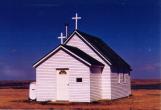
92
Glentworth Assumption of the Blessed Virgin Mary Ukrainian Catholic ChurchOn January 9, 1914, thirty one men signed a document to purchase one acre of land for a cemetery. In 1923, twenty one men withdrew from the agreement. From the remaining ten, seven families decided to build a Ukrainian Catholic Church on land near the cemetery.
The men raised funds by Christmas caroling and solicited donations.
Building began in 1925. There were no regular priests, but people still came together to pray realizing how fortunate they were to have all that they had in their new home, Canada. Services were held on special occasions.
The building was dedicated to the Assumption of the Blessed Virgin Mary.
94
QuestionI understand that the settlers never had much money. How did they ever pay for the upkeep of the church building or the minister's salary?
Answer
Life in Lisieux and most parishes centered on the church. The social life of the congregation included drama nights, card parties, and such events as pie sales, bazaars, and basket socials which were used to raise funds necessary to maintain the parish.
These events filled most of the Sunday evenings during the winter months especially the Fowl suppers that were well attended and presently these continue to be well attended by many from neighbouring churches congregations.

